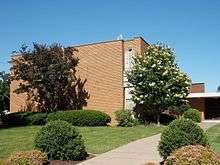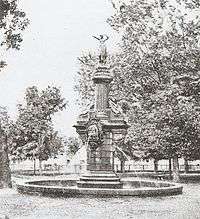Temple Emanuel (Davenport, Iowa)
| Temple Emanuel | |
|---|---|
 Mississippi Avenue facade | |
| Basic information | |
| Location |
1115 Mississippi Avenue Davenport, Iowa |
| Geographic coordinates | 41°31′55″N 90°33′12″W / 41.532°N 90.55321°WCoordinates: 41°31′55″N 90°33′12″W / 41.532°N 90.55321°W |
| Affiliation | Reform Judaism |
| Status | Active |
| Leadership | Interim Rabbi Scott Saulson; Rabbi Henry Jay Karp, Emeritus; Cantor Gail Posner Karp, Emerita |
| Website |
qctemple |
| Architectural description | |
| Architectural style | Mid Century Modern Architect: Percival Goodman, the leading theorist of modern synagogue design |
| Groundbreaking | 1952 |
| Completed | 1953 |
| Construction cost | $375,000 |
| Materials | Brick and Concrete |
Temple Emanuel is a Reform synagogue located on the east side of Davenport, Iowa, United States. Organized in 1861, it is the oldest Jewish congregation in Iowa. It has a membership of 150 families, and it is affiliated with the Union for Reform Judaism (UAHC).
History
Among the first 500 residents of Davenport in the late 1830s and early 1840s were 12 people who were Jewish.[1] There was no attempt to organize a congregation until more substantial numbers immigrated from Germany in the 1850s. Mount Nebo Cemetery, adjacent to Pine Hill Cemetery, was organized at that time. By 1860 there were eleven Jewish families in town.[2] On October 21, 1861 they organized the B'nai Israel congregation,[3] the first Jewish congregation to organize in the state of Iowa.[1] In 1862 they rented the third floor of the building where the Forrest Block now stands for use as a synagogue. The constitutions and by-laws were accepted and approved on December 6, 1862.[3] The congregation floundered somewhat in its early years until it was more fully organized in 1874.[2]
Rabbi Isaac Fall, who was Orthodox, led the community for 15 years in the late 19th century. It was during this time that the congregation began to embrace the Reform movement. Women were accepted on an equal basis with men and men did not have to cover their heads during worship.[2] Dissention was also caused when services were held in English rather than German. The congregation officially affiliated with the Union of American Hebrew Congregations (UAHC) in 1879, just six years after it formed.[3] The first synagogue was built under Rabbi Fall’s leadership in 1885 on Ripley Street, across the street from the Scott County Courthouse. It was named Temple Emanuel. The Orthodox formed their own congregation, B'nai Ameth, in 1894. They did not, however, have a regular rabbi until 1907 nor a synagogue of their own until 1909. With the death of its lay leader, Harry Lipsman, the Orthodox congregation closed in 1963. By 1900 there were about 50 Jewish families in Davenport.[1]
A second Temple Emanuel was built at Brady and Eleventh Streets in 1906. Newspaper publisher E.P. Adler helped the congregation through the Great Depression years. In 1944 the city block at Twelfth Street and Mississippi Avenue was purchased and the current synagogue was built from 1952-1953. It was built in the Modern architectural style for $375,000[1] ($3.43 million in present-day terms[4]). In 2011 when they celebrated their 150th anniversary, Temple Emanuel counted 150 families in its congregation.[1]
References
- 1 2 3 4 5 Cox Baker, Deirdre. "Temple Emanuel celebrates 150 years". Quad-City Times (April 14, 2011). Retrieved 2011-10-09.
- 1 2 3 Svendsen, Marls A., Bowers, Martha H (1982). Davenport—Where the Mississippi Runs West: A Survey of Davenport History & Architecture. Davenport, Iowa: City of Davenport. pp. 11–5.
- 1 2 3 "About Us". Temple Emanuel. Retrieved 2011-10-09.
- ↑ Federal Reserve Bank of Minneapolis Community Development Project. "Consumer Price Index (estimate) 1800–". Federal Reserve Bank of Minneapolis. Retrieved January 2, 2018.
